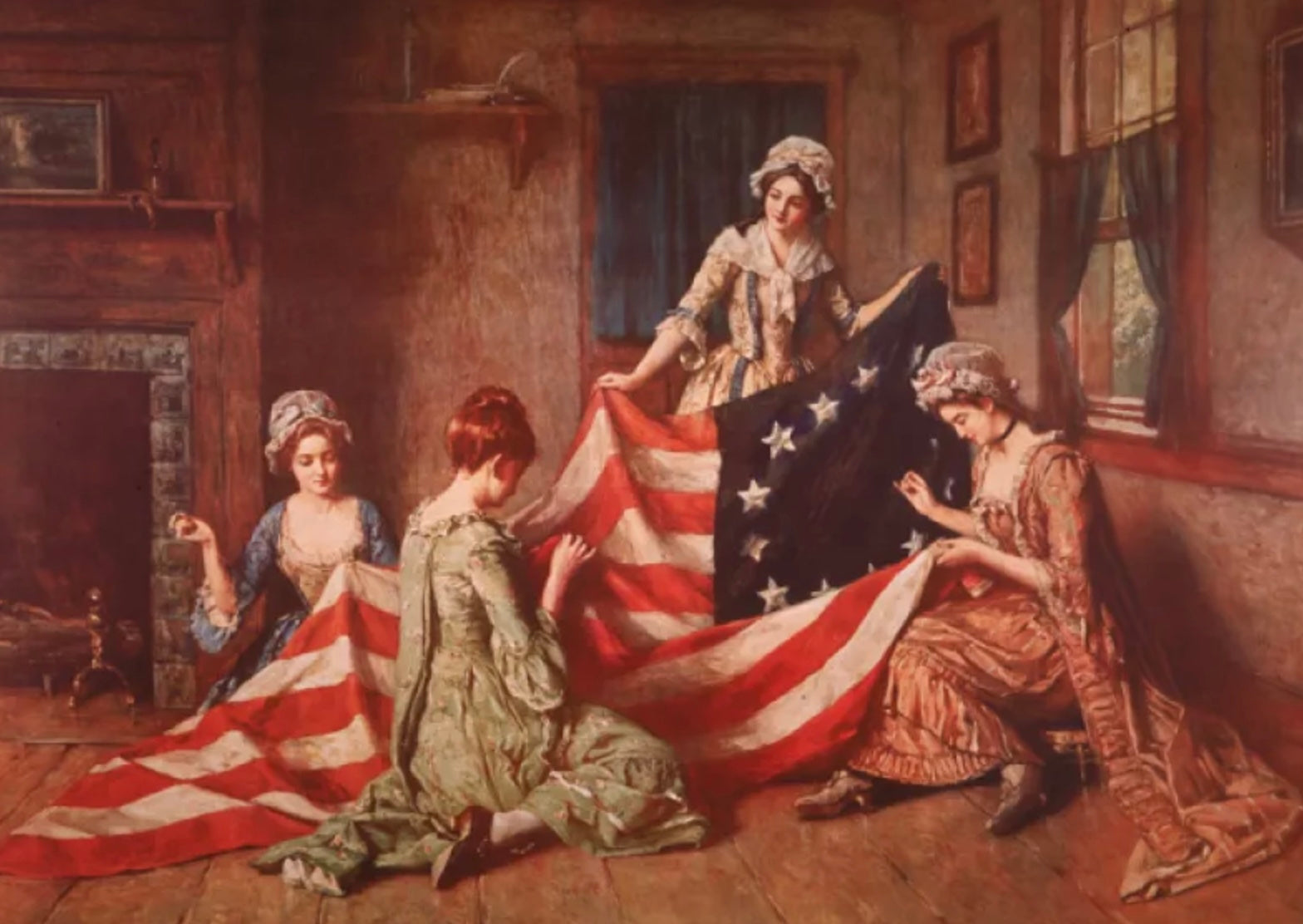Early American Flags
The American flag is not a standalone, original design that was sprung up out of nowhere. It was the culmination of important historical events and artistic meaning with roots aging back to England.
British Union Jack
The Betsy Ross flag was heavily inspired by the British flag. The Union Jack is an amalgamation of three separate flags combined under Britain. The red cross on a white field originally represented England.
It was named after the Saint of the country: Saint George and is called the St. George flag. The funny thing is that Saint George was not really English. He was born in Turkey and died in modern-day Israel, living during the 3rd century.
Scotland’s flag, the white “X” on a blue field, comes from Saint Andrew. In a similar fashion to the English flag, Saint Andrew was not Scottish and was crucified on an “X” shaped cross. Hence the white “X.”
King James I was the first monarch to rule over England and Scotland at the same time and commissioned a flag to commemorate the union. The design was basically the English flag layered on top of the Scottish flag and looked very similar to what it is today.
In 1801, Ireland joined the union. Ireland’s flag was a red “X” on a white field that represented Saint Patrick, who was not Irish. He was actually English. When Ireland’s flag design was imported onto the English flag, it’s represented by the thinner red “X” that is overlaid on the white background.
The British Empire acquired countries around the world and stamped their Union Jack onto those country’s flags, usually in the canton. At one point in time, 49 commonwealth countries had the Jack incorporated into the national flag design.
First American Flag
It’s commonly accepted by historians that the Grand Union flag was the first American flag but in an unofficial capacity. It is strikingly similar to today’s flag, with the exception of the British Union Jack in the canton.
There were a couple of compelling reasons as to why the colonies used this flag. For one, it was the same design as the East India Company flag. The East India Company was one of the most powerful companies to have ever existed in history.
And it played a large role in the Boston Tea Party. The company was established by the British government in 1600 and was the primary trading and transportation company for the Empire.
Before the Revolutionary War, George Washington wanted to both appease Britain and the East India Company. Obviously, things soured between the colonies and Britain during the American Revolution.
Sons of Liberty Flag
After the Stamp Act of 1765, a somewhat secret society was formed to discuss matters regarding the rights of American colonists and unfair taxes: These people called themselves the Sons of Liberty.
The group was founded by Samuel Adams, a politician from Massachusetts. The flag they flew was the rebellious red and white stripes. Not much is actually known about what was discussed during their meetings because of their secrecy.
Later on, the group would participate in the Boston Tea Party, and there were many branches of the Sons of Liberty by that time.
Betsy Ross’s Flag
The first stars and stripes American flag would keep the religious stripes not only to represent the original thirteen colonies but the rebellious nature of the colonists as well.
Betsy Ross’s Life
In 1752, Betsy Ross was born Elizabeth Griscom in New Jersey and grew up with Quaker ideals. To get her professional footing, she was an upholsterer’s apprentice. During her life, she worked with her husband, John Ross (a relative of Colonel George Ross), and had their own upholstery business.
Not much is known about Ross, and there is no official documentation or much historical evidence that indicates she made the first flag of the United States. There is, however, anecdotal evidence and affidavits that show that it is very possible that she was approached by General George Washington. It is believed Washington and Ross crossed paths one year before the Second Continental Congress in June.
Her first late husband would die during the war. She would later marry Joseph Ashburn and then John Claypoole. Betsy Ross died in Philadelphia in 1836.
It is largely her connection to George Ross and Robert Morris that suggests Ross's relationship with the original American flag. Her grandson, William Canby, is the one who brought this story about his grandmother to the Historical Society of Pennsylvania. However, other people claim that Francis Hopkinson (the man behind many government seals) was more involved in the flag creation than Ross.
It’s not a far stretch to consider that she may have worked on other things for the White House in her time. It’s possible that she was involved in other seamstress duties.
Significance
The United States is all about independence and rugged resilience, and the flag represents those qualities. Back in the days of the thirteen colonies, people who lived in the settlements had to make their way completely on their own.
There wasn’t much help coming besides British tax collectors. Infrastructure had to be built from scratch. Back in Britain, there were established and supported institutions that helped the government and economy.
For the new settlers, they had to build buildings, make bridges, and settle the land. The new blue field and stars were a statement about our resilience and hardiness in the making of America.
Old Glory
By 1777, the American flag really began to start looking familiar to our flag today. At times, the flag had additional stripes for new states. Can you imagine an American flag with fifty stripes?
Design
The blue field that took the place of the Union Jack was both a call-back to British origins and a symbol of independence. The thirteen silver stars were also representative of our newfound freedom.
All three colors on the flag mean something:
- Red means valor and hardiness.
- White is for purity and innocence.
- Blue represents justice, vigilance, and perseverance.
The placement of the thirteen stars is a topic of debate among historians. It’s most likely that the stars were, in fact, placed in a circle just like the ones we see in the media. George Washington said, “Let the 13 stars in a circle stand as a new constellation in the heavens.”
There have been different ideas and interpretations over the years, with some concepts showing the stars scattered in the blue field and others with them in a grid-like pattern. It is, however, important to remember the relevance of what George Washinton said.
He meant for all thirteen states to be equally represented. Other designs would have placed some states above others. That philosophy started to change with the addition of new states, though. Stars simply became too crowded, and they would eventually become too small if the circle design stayed.
The silver stars were originally supposed to have six even points by the request of George Washington and the committee. Ross was allegedly the one to suggest five-pointed stars for expediency sake.
Washington and the committee protested this idea with the idea that six-pointed stars were easier to make. Ross changed their minds by showing a way on folded paper to make five-pointed stars with one single snip.
Washington and the committee members were impressed; they approved the change along with some other minor details Ross had suggested.
Is There an Example Still in Existence?
That is why historians and vexillologists are still skeptical of the circular star design today, as we do not have any physical relics of this old version of the American flag. We are basically at the mercy of historical documents and testimonies.
Many of the famous American paintings we are familiar with feature the design with the stars in a circle, but the majority of those pieces were made in the mid to late 1800s. It’s not like the artists were going out of their way to make an unfaithful representation of the flag, though.
They were simply working with the knowledge that was available, and the circular design was the most likely candidate.
Star-Spangled Banner
Remember the “Star-Spangled Banner”? During the War of 1812, Commander of Fort McHenry, George Armistead, commissioned a new flag from Mary Pickersgill. Francis Scott Key was so inspired by the US militias fighting the British that he penned this national anthem.
This version of the flag had fifteen stars and fifteen stripes representing the addition of Vermont and Kentucky into the Union. The number of stripes was changed later on back to thirteen, likely because the addition of new stripes would eventually be too cluttered.
The flag Mary Pickersgill had made was originally 30 feet by 42 feet but was reduced to 30 feet by 34 feet after the battle it survived. This particular example still exists today in a museum.
To give a sense of scale, each of the fifteen stars on the flag was two feet in diameter, and each stripe was two feet wide. In the 1800s, relics and pieces related to American history were highly collectible, and the Star-Spangled Banner was unfortunately subjected to this.
Over the years, small pieces of the flag were given to government officials and war veterans. In 1907, the flag was given to the Smithsonian, and a major conservation effort went underway in 1914 for what was left of the flag. This example remains one of the earliest surviving examples of American history.
Ghost of Freedom’s Past
Betsy Ross, Philadelphia upholsterer, is a name mired in controversy, but nobody else has made a more ligament claim to disprove their theory. The accounts by family and others seem convincing, and it makes for a great American tale. The red, white, and blue of the flag are synonymous even with July 4th, our nation's patriotic holiday.
Sources:
Betsy Ross and the American Flag facts | US History.org
Three Cheers for the Red, White, and Blue Star-Spangled Banner | Smithsonian
How the East India Company Became the World's Most Powerful Monopoly | Yale MacMillan Center
The Rebellious Strips of the Sons of Liberty | United States District Court”





